Eurocom Monster 1.0: Clevo's Little Monster
by Vivek Gowri on May 18, 2012 4:55 AM EST- Posted in
- Laptops
- Clevo
- Eurocom
- Ivy Bridge
- Kepler
A Powerful 11.6" Laptop
Well, this is the part everyone has been waiting for. I’ll just let the numbers speak for themselves here. The Monster is fast by notebook standards, phenomenally so when compared to other machines in this size class. It’s just an order of magnitude faster than just about anything else in the 11-13” range. The M14x R2 is probably the closest you’re going to get, and that’s a solid two pounds heavier than the Monster.
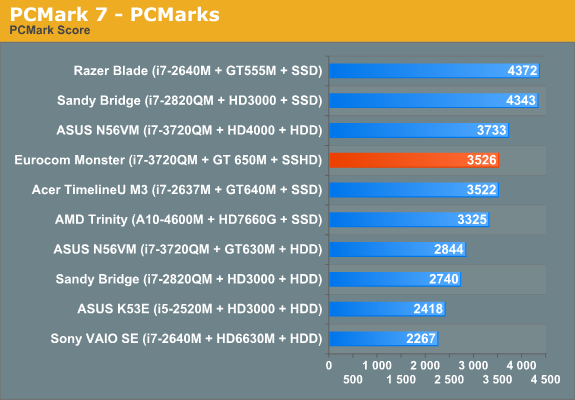
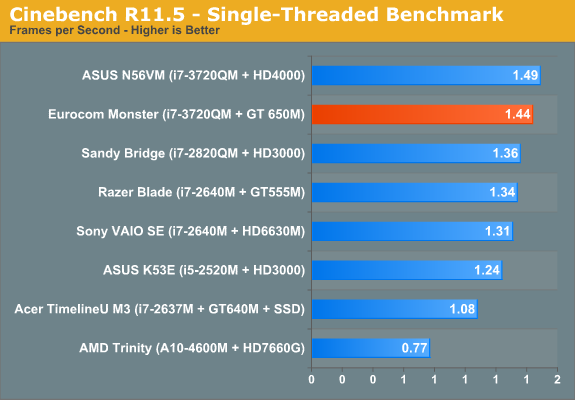
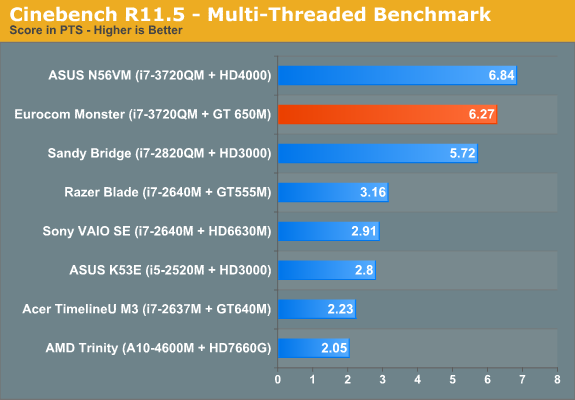
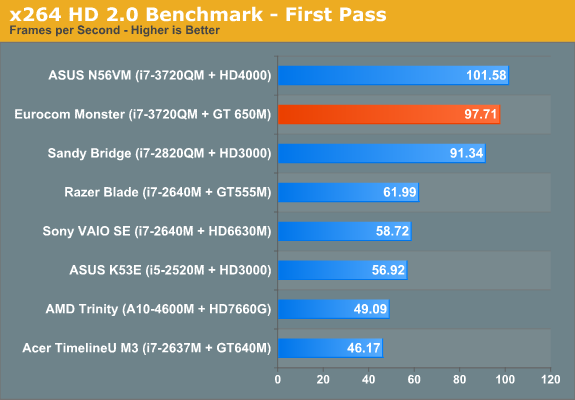

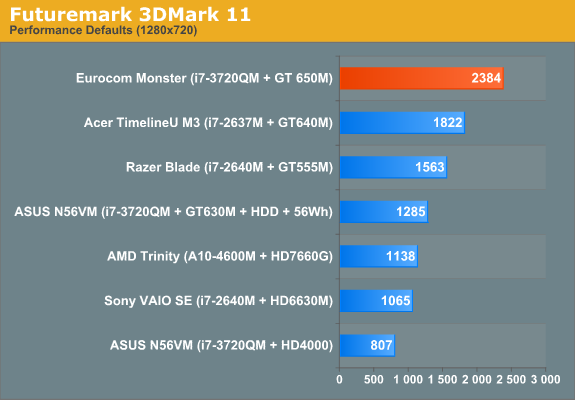
Jarred did a deep dive into the performance of the mobile IVB quad-core chips in the Mobile Ivy Bridge Performance Preview, so you can take a look at more benchmarks and the improvements in Quick Sync and the integrated GPU there. The ASUS N56VM we looked at in that piece had the same i7-3720QM processor as our Monster evaluation unit, so results are very comparable.
IVB is considered a tick+, bringing new lithography along with an architectural overhaul on the GPU side, but the CPU microarchitecture in IVB is pretty similar to SNB. As we noted in the performance preview, raw CPU performance hasn’t really improved that much over SNB, with differences in the 10-20% range. It’s decent, but not life-changing in the same way as the jump from Clarksfield to SNB.
A note on hybrid hard drives—if you’re looking for consistent SSD-like performance, you’re going to be disappointed. Which might sound obvious, but I’m not talking about it in the numbers sense; other than boot times, the Momentus XT just doesn’t feel as consistently responsive as an SSD tends to be. In fact, it doesn’t feel particularly more responsive than a typical 2.5” 7200RPM hard drive. The problem is down to the fact that the NAND cache isn’t predictive, so the first few times you do anything, it feels like a standard 7200RPM drive. Over time, it’ll eventually store the most frequently read data into cache and deliver near-SSD performance for that data, but until that happens, along with any workflows outside of the cached data, the drive will feel agonizingly slow. On a system that has this level of raw compute horsepower, the hybrid drive is a serious bottleneck. You’re better off with any newer SSD, and relying on a USB 3.0 external hard drive if you need extra storage space. With 120GB SF-based drives starting to go lower than the $1/GB mark, there’s no reason not to do it anymore.










47 Comments
View All Comments
fic2 - Friday, May 18, 2012 - link
Cue the lawsuit from Monster Cable in 3, 2, 1...hsew - Friday, May 18, 2012 - link
This needs an mSata port and a higher resolution display option and it would be worth buying. Thunderbolt would be nice but not critically necessary. Guess that's why they called it the 1.0.Beenthere - Friday, May 18, 2012 - link
...and a 45w CPU for a 11.6" laptop sure don't make good sense.RoninX - Friday, May 18, 2012 - link
It would be interesting to see a comparison, in terms of design and hardware options, of all the different OEM varieties of this Clevo (Eurocom, Origin, Maingear, etc.). Of course, the performance will be similar, if not identical, but the look and feel, and the choices in terms of screens and SSDs, may be different...Also, is there any way to get a 9-cell battery for this?
slim142 - Friday, May 18, 2012 - link
This laptop in 14" with Matte screen, 1680x1050 (or, if too much, then 1440x900) resolution. I would jump on it immediately.maniac5999 - Friday, May 18, 2012 - link
Actually, I have a 12" laptop (MSi Wind 230) and I think that 768p is the right resolution for this size.yhselp - Saturday, May 19, 2012 - link
It really boggles my mind when competent people, even professionals, make subjective claims about products. Did they get caught up in marketing to such an extent that they're no longer able to see a product for what it really is? When was the m11x anything but a shameless, uninnovative shirking of an already dated chassis? A thick notebook which weighs as much as a regular 13.3-incher, yet has a tiny screen and unimpressive components. I'm not saying it's a bad product per se, just an unimaginative one that doesn't push the envelope in any way. Not to mention a glossy screen on an 'ultraportable' machine, although that's a problem with so many products nowadays.What I'm trying to say here, as someone who knows a little about thermal design, is that very few notebooks on the market make optimal use of TDP, and as a result the public has an unrealistic opinion of what's possible. Many people would be surprised by what components you can actually stuff in a given chassis. I don't feel competent enough to say why that is, but I suspect it has something to do with companies being reluctant to develop (and well) new designs as often as they should - even Apple.
W110ER is not a thermal miracle, it doesn't break the laws of physics - it just makes adequate use of thermal limits. However, it's fair to say that the inclusion of 45W CPUs is quite bold (not in a bad way). As for the product itself - it's pretty good (apart from the generic outer design), although I feel that it lacks focus. I'd much rather have either a truly portable 11.6-incher that weighs under 3 lbs and packs a ULV + 640m, or a more practical (and still portable) 13.3-incher at 4.5 lbs with a 35W quad-core + 660m.
I really like it how you guys at AnandTech constantly preach about better displays. In your Vaio SE review you said that its IPS panel should be the bare minimum nowadays - I agree. And to that I'd also add proper thermal optimization. Perhaps Haswell will bring that.
I hope I haven't been offensive, that was not my intent.
VivekGowri - Sunday, May 20, 2012 - link
Set a 4.5lb weight limit, and how many decent gaming systems have there been over the last 3 years? The M11x, the VAIO SA, the first two generations of VAIO Z series (not the new Power Media Dock one), and how many others? The M11x was really the only one of those to be focused on gaming, and the GT 335M was pretty sweet at the $799 price point (in 2010). I wasn't really a huge fan of the M11x (in any of its 3 iterations, actually) primarily due to the size/weight vs screen size, but it was relatively unique in pushing the concept of portable gaming, and that's all the opening paragraph was trying to say.ijozic - Monday, May 21, 2012 - link
Well, there is the 13,3" LG P330 which has a much better design and materials (IMHO), though it's dual core + 555M (somewhat slower than the 650M). Unfortunately, it has a glossy screen, no backlighted keyboard and it's only available in Korea. Hopefully, they'll make an IB refresh and release it worldwide.yhselp - Tuesday, May 22, 2012 - link
Yes, the LG P-series are (and have been) generally well optimized portables. Unfortunately, they've also never been widely available in the US or anywhere outside Korea for that matter. I wonder whether anyone remembers the excellent LG P300 - it used to be a direct competitor to the famous Dell M1330. Unlike the Dell, however, it had a 8600M GS (compared to the slower 8400 GS), better battery life and a somewhat sturdier design. It was quite the machine back then.